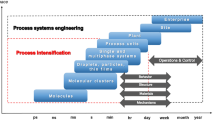Abstract
Publications on the mechanisms of ammonia synthesis on an iron catalyst and methanol synthesis on a copper zinc aluminum catalyst were analyzed. Based on the analysis of the energy balance of individual reaction steps, a hypothesis was put forward that hydrogen is a source of energy required for the chemisorption of other reagents. In the ammonia synthesis, this occurs through the formation of surface iron hydrides; and in the methanol synthesis, surface zinc hydrides. An energy diagram was constructed, which shows that, at the dissociation step, fragments of the adsorbed nitrogen molecule receive additional energy through the formation of iron hydride, and this energy ensures the breakdown of the bond in the nitrogen molecule. A scheme of the methanol synthesis was proposed, according to which the copper surface and the zinc oxide surfaces of the catalyst are independent phases: the synthesis occurs on the copper surface, whereas the intermediate step of CO oxidation to CO2 proceeds on the zinc oxide surface and the copper surface simultaneously. The mechanism of the CO2 conversion to methanol was considered, which comprises the steps of binding of CO2 to hydrogen chemisorbed on the copper surface, formation of formate, hydrogenation of formate to formic acid, and decomposition of formic acid into hydroxyl and formyl with further hydrogenation to methanol. In this case, CO2 molecules move from the zinc oxide surface to the copper one, and H2O molecules migrate in the opposite direction. The heterogeneous catalysis was considered from the standpoint of the potential theory of adsorption, within which kinetic equations for the ammonia synthesis and the methanol synthesis were proposed. The purpose of this work was to refine the mechanism of the considered processes.




Similar content being viewed by others
REFERENCES
Menshov, V.N. and Tubin, L.A., Russ. Chem. Bull., 2018, vol. 67, no. 6, p. 1104.
Borso, F., Ertl, G., Grunze, M., and Weiss, M., J. Catal., 1977, vol. 49, p. 18.
Ertl’, G., Li, S.B., and Vais, M., Kinetics of nitrogen adsorption on Fe(111) surface, Nauka o Poverkhnosti, vol. 114, 1982, p. 515.
Anokhin, V.N, Men’shov, V.N, and Zuev, A.A., Zh. Prikl. Khim., 1975, vol. 18, no. 3, p. 16.
Anokhin, V.N., Men’shov, V.N., Tarasov, L.A., Sharkov, A.V., and Babankov, V.P., Theoretical Foundations of Catalysis in Technology of Bonded Nitrogen, Moscow: NIITEKhIM, 1978, vol. 1, p. 33.
Rozovskii, A.Ya. and Lin, G.I., Teoreticheskie osnovy protsessa sinteza metanola (Theoretical Foundations of Synthesis of Methanol), Moscow: Khimiya, 1992, p. 272.
Chorkendorf, I. and Naimantsvedrait, Kh., Sovremennyi kataliz i khimicheskaya kinetika (Modern Catalysis and Chemical Kinetics), Dolgoprudnyi: ID Intellekt, 2013, p. 504.
Waugh, K.C., Catal. Lett., 2012, vol. 142, p. 1153.
Chinchen, G.C., Mansfied, K., and Spencer, M.S., Chemtech., 1990, vol. 20, p. 692.
Volnina, E.A. and Kipnis, M.A., Kinet. Catal., 2020, vol. 61, no. 1, p. 119.
Norskov, J.K., Rep. Prog. Phys., 1990, vol. 53, no. 10, p. 1253.
Woll, C., Prog. Surf. Sci., 2007, vol. 82, p. 55.
Wang, Y., Meyer, B., Yin, X., Kunat, M., Langenberg, D., Traeger, F., Birkner, A., and Woll, Ch., Phys. Rev. Lett., 2005, vol. 95, p. 266104.
Rozovskii, A.Ya. and Lin, G.I., Top. Catal., 2003, vol. 22, p. 137.
Kuznetsov, A.M., Sorovskii Obrazovatel’nyi Zh., 2000, vol. 6, no. 5, p. 45.
Kattel, S., Ramirez, P.J., Chen, J.G., Rodriguez, J.A., and Liu, P., Science, 2017, vol. 355, p. 1296.
Grabow, L.C. and Mavrikakis, V., ACS Catal., 2011, vol. 1, p. 365.
Barkovskii, A.I., Pomerantsev, V.M., and Anokhin, V.N., Physicochemical Fundamentals of Synthesis of Methanol. “Metanol-3.” Proc. 3rd All-Union Workshop, Nauka, 1986, p. 16.
Author information
Authors and Affiliations
Corresponding author
Ethics declarations
The authors declare that they have no conflicts of interest.
Additional information
Translated by V. Glyanchenko
Rights and permissions
About this article
Cite this article
Men’shov, V.N., Tubin, L.A. The Role of Hydrogen in the Reactions of Synthesis of Ammonia and Methanol. Kinet Catal 62, 744–749 (2021). https://doi.org/10.1134/S0023158421060124
Received:
Revised:
Accepted:
Published:
Issue Date:
DOI: https://doi.org/10.1134/S0023158421060124




